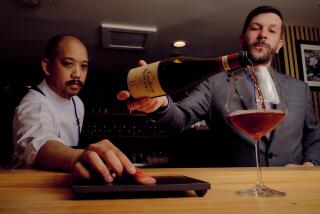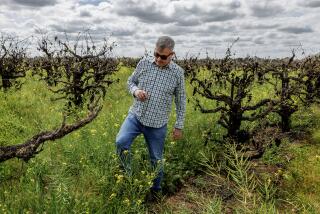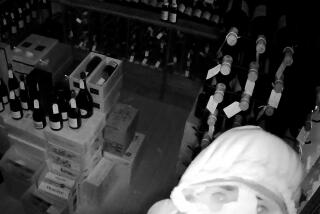The Other White Wine
Sauvignon Blanc, long known as the poor manâs Chardonnay, is very much earning its own niche in the wine world, and not just because itâs generally cheaper than Chardonnay. Often itâs simply a better choice with food.
To tell the truth, the Olken family often orders Sauvignon Blanc in restaurants rather than pay Chardonnayâs inflated prices, which can dwarf the cost of the food. But price aside, Sauvignon Blanc just suits the way we eat these days. Like many Americans, we have moved away from the âsteak or hamburger every dayâ idea and eat more fish, chicken or even vegetarian meals, especially in hot weather.
Sauvignon Blanc has higher acidity than most Chardonnays and seems a more natural partner for simple broiled or grilled fish. The richer, riper Sauvignon Blancs often get our nod with salmon. We like to serve the Sauvignon Blancs that have a green or grassy streak when weâre having meatless or herb-seasoned dishes.
Because today is Bastille Day, Franceâs equivalent of the Fourth of July, Iâm including a couple of French Sauvignon Blancs from the Loire Valley. The French themselves long underestimated the firm, smoky, flinty, well-fruited wines of Sancerre and Pouilly-Fume, but theyâve been turning to Sauvignon Blanc for the same reasons we have. The best white Burgundies sometimes have perfectly outrageous prices these days, and the French too have been changing their eating habits. More and more, theyâre choosing Sauvignon Blanc for its value, and for its suitability to their new directions in food.
** 1997 Napa Wine Company, Napa Valley, $20. This brilliantly crafted wine may have lost out on a third star because it lacks a bit of intensity, but it is a joy to drink. It has an impeccable balance of bright fruit and quietly supportive oak, hints of lettuce leaves and a firm yet rich, lingering finish. I think this is my favorite Sauvignon Blanc for lighter fish and chicken preparations. By the way, Sauvignon Blanc is not usually considered a wine for cellaring, but this one will do very well with a bit of time in bottle.
** 1997 Kenwood Vineyards âReserve,â Sonoma Valley, $16. This ripe, toasty, smoky wine is a different breed of cat. It is far more fruity than the preceding wine, and it comes in a round, fleshy style perfect for drinking with a fatty fish such as salmon, or perhaps a roast chicken. âExuberantâ is not really a wine-descriptive word, but if it were, it would apply to this straightforward, outgoing effort.
$ ** 1997 Chateau Ste. Michelle âHorse Heaven Vineyard,â Columbia Valley, Wash., $14. This wine includes 17% Semillon in the mix, and that minor addition (common in white Bordeaux) helps explain the lightly floral notes that enhance the wineâs citrusy, melony fruit. It has hints of grassiness and oak and a suggestion of minerals, together with brisk acidity. Try it with tangy seafood preparations or shellfish dishes ranging from fresh-shucked oysters to crab and mussel stew.
$ * 1998 Benziger Winery & Vineyards Fume Blanc, Sonoma County, $11. Sometimes you just want a nice, bright, well-balanced, not too complicated white wine that goes with almost anything. Here is such a wine. Young, energetic, smelling of melons and grass and with fruit deep enough to match its acidity, this wine (like the 1997, which is still available) fills the bill nicely. Frequently discounted.
$ * 1997 Geyser Peak Winery, Sonoma County, $8.50. Yet another wine that is tasty and inexpensive. This widely available, often discounted bottling offers about as much value as youâll find in any white wine today. It is decidedly tangy at the finish, making it better with seafood than with richer chicken dishes. Itâs also good for quaffing by itself.
1997 Beringer Vineyards, Napa Valley, $10. I mention this wine because itâs an exception to the rule--it has the rounded, slightly sweet character of a wine to go with a light lunch or simply for sipping. Beringerâs version of this grape has a quiet personality of grass and Meyer lemons with a suggestion of honey. Serve it with a slice of cold ham or some chicken with a curried rice salad. It too is often seen at discounted prices.
** 1997 Jean Reverdy et Fils Sancerre âLa Reine Blanche,â $21. A textbook example of the sleek, herb-scented, refreshing wines of Sancerre. This crisp, flinty offering provides an interesting contrast to the riper, juicier style that we see so often in California Sauvignon Blancs. On a recent visit to Paris, I chose this wine to accompany a piece of Dover sole served with a lightly herbed cream sauce accented with baby shrimp and a dollop of caviar.
* 1997 Herve Seguin Pouilly-Fume, $15. Lightly herbal and, predictably, a bit rounder than its cousin from Sancerre, this medium-depth offering sports reasonable fruit with stony, flinty highlights. Another lighter but likable rendition of the grape.
Tasting Notes is based on tastings conducted by Connoisseursâ Guide to California Wine, a monthly newsletter devoted to the critical review of California and West Coast wines. Readers of the Times may obtain a sample copy by sending their name and address to: CGCW, P.O. Box V, Alameda, CA 94501, by calling or faxing, (510) 865-3150 or by e-mailing [email protected].
(BEGIN TEXT OF INFOBOX / INFOGRAPHIC)
Definition of Symbols
* * * A world-class wine, superb by any measure, the top 1% to 2% of all wines tasted.
* * An exceptional wine, well worth the effort to find, 10% to 12% of wines tasted.
* An admirable wine, tasty, focused, attractive, about 25% of wines tasted.
No Rating: The best are quite pleasant and can be good buys when moderately priced.
$ Good value for the money.
x Below average quality, to be avoided.
More to Read
Eat your way across L.A.
Get our weekly Tasting Notes newsletter for reviews, news and more.
You may occasionally receive promotional content from the Los Angeles Times.










